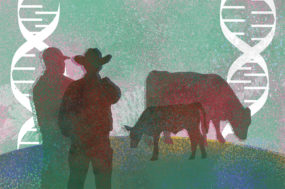- 74 percent of consumers could not think of additional information they would like on labels.
- 8 percent wanted more information on nutrition.
- 5 percent wanted more information on ingredients.
- 4 percent wanted more information on biotechnology or related subjects.
- 63 percent supported current labeling of biotechnology production only if nutritional content is significantly changed or there is a potential safety concern such as an allergen.
- 19 percent (up from 14 percent in a 2012 survey) disagree that current biotechnology labeling is sufficient.
On the topic of food biotechnology perceptions:
- 71 percent said they know something about plant biotechnology.
- 28 percent had favorable perceptions toward plant biotechnology.
- 28 percent (up from 20 percent in 2012) had unfavorable perceptions.
- 43 percent were neutral or did not know enough to comment.
- More aged 18 to 34 had favorable perceptions than those over 34 years of age.
Regarding how biotechnology should be used in food production:
- 72 percent said to increase healthful fat content (such as omega-3 fatty acids).
- 69 percent said to reduce potential for carcinogens.
- 69 percent said to protect from insect damage and reduce use of pesticides.
- 67 percent said to enhance nutrition.
- 67 percent said to eliminate trans-fat content.
As to perceptions of modern agriculture, responses were:
- 74 percent agreed that farming with modern tools and equipment can be sustainable.
- 72 percent agreed modern farming can produce high quality and nutritious food.
- 68 percent agreed modern farming produces safe food.
- 52 percent agreed that modern farming is primarily family operated.
“Sustainability” received the following responses:
- 57 percent had read or heard about sustainability related to food production.
- 66 percent said it is important to produce food sustainably.
- 26 percent (down from 33 percent in 2012) would spend more for food produced sustainably.
Effect of trace mineral injections on pre-weaned and post-weaned calves
One-half of a group of 150 Brangus-crossbred calves was injected at 100 and 200 days of age with 1 ml of a product containing 60, 10, 15 and 5 mg/ml of zinc, manganese, copper and selenium, respectively.
The other one-half was injected at the same times with saline solution. All calves were weighed on days 100, 150, 200 and 250 when weaned. Liver biopsies were taken from 12 calves per treatment on days 150, 200 and 250. Trace-mineral injections had no effect on average daily gain (ADG) but did increase concentration of copper and selenium in the liver.
In a second study, one-half of a group of 34 weaned heifers was weighed and injected with 2.5 ml of the product described above on day zero, 51 and 127. The other half was weighed and injected with saline solution at the same times. On day 177, heifers were weighed and liver samples taken. ADG and selenium concentrations were significantly higher for the group receiving trace-mineral injections.
Marbling – Just a little can mean a lot
Marbling, the flecks of fat within muscle, is the primary determinant of official USDA Quality Grade. Marbling is officially evaluated in the rib eye between the 12th and 13th ribs, i.e., where a carcass is separated into forequarter and hindquarter.
Slight marbling is the minimum required for USDA Select and small marbling is required for USDA Choice. Just a few flecks divide those two grades, but that can mean a lot of money. Over the last few years, the average spread between Choice and Select is about $8 to $9 per hundredweight (cwt) carcass but has ranged from $0 to $20 per cwt.
Modest marbling gets a carcass into the upper two-thirds Choice, the minimum required for most branded high-quality programs such as Certified Angus Beef (CAB). The premium for CAB over Choice currently is about $4 per cwt carcass. Slightly abundant marbling and higher results in a grade of USDA Prime. That premium currently is about $20 per cwt over CAB. However, only 3 to 4 percent of fed beef grades Prime.
How is marbling determined? Until recently it was done exclusively by an official grader’s eyeball. Now, grading is increasingly done by instrument, subject to adjustment by a grader. Properly calibrated instruments should result in the most accurate and repeatable evaluation. Regardless, higher marbling usually means higher value. How much higher depends on the value spreads, and those still depend largely on supply and demand.
An alternative program for synchronizing heat?
A common program for synchronizing heat for artificial insemination is the five-day CO-Synch plus controlled internal drug release (CIDR) protocol.
The standard five-day protocol includes an initial administration of gonadotrophin-releasing hormone (GnRH) at insertion of an intravaginal progesterone releasing device (CIDR), followed five days later by two doses of prostaglandin (PGF2α), given approximately eight hours apart, and CIDR removal and timed artificial insemination (TAI) with a second GnRH 72 hours after PGF2α.
A study was designed to evaluate the necessity of the first administration of GnRH and of two PGF2α doses rather than one. The study involved four locations and 823 Angus x Simmental, Angus x Hereford, Charolais or Angus yearling heifers:
At CIDR insertion, one-half of all heifers received GnRH and one-half did not. At CIDR removal, all heifers received PGF2α. All heifers were timed artificially inseminated, and all received GnRH 72 hours after PGF2α. Pregnancy was diagnosed at 32 and 38 days after TAI.
At CIDR withdrawal, presence of a new corpus luteum was significantly higher in the group receiving GnRH twice. However, there was no significant difference in pregnancy rate to TAI between heifers receiving GnRH twice (50.5 percent) or once (54.9 percent).
The authors concluded that omitting the initial GnRH administration did not influence pregnancy rate and that only one dose of PGF2α was effective.
Effect of type of bermuda grass on forage characteristics and animal performance
Alicia, Jiggs and Tifton-85 bermuda grasses were evaluated over four consecutive years. Weaned, 9-month-old three-eighths Gelbvieh, three-eighths Red Angus, one-fourth Brahman steers, averaging 554 pounds, initially were grazed for an average of 112 days from June to September.
Before grazing started, hay was cut and pastures were fertilized with 40 pounds of nitrogen per acre. Forage samples were taken when grazing started (day zero) and on days 28, 56, 84 and 112. A free-choice mineral-vitamin mix (containing 12 percent calcium, 6 percent phosphorus, 10 percent sodium chloride, trace minerals and 2,000,000 units of vitamin A) was provided throughout the grazing period.
As expected, percentage of crude protein and digestibility declined during the summer grazing period. Alicia had lower digestibility than both Jiggs and Tifton-85, resulting in significantly better performance on Tifton-85 (1.21 pound ADG) and Jiggs (1.12 pound ADG) than Alicia (0.79 pound ADG).
Estimates of temperament in Brahman and Brahman-cross
Over a 10-year period, 1209 Brahman and Hereford x Brahman calves, weaned at a average of 186 days of age, were evaluated for temperament. Temperament was evaluated as one, chute velocity (time taken to travel 6 feet from the squeeze-chute release); two, pen score (a subjective estimate of “willingness to be approached by a human” where 1 equals nonaggressive to 5 equals very aggressive); and three, temperament score (a combination of chute velocity and pen score).
Evaluation was done 28 days before weaning, at weaning, 28 days after weaning, 56 days after weaning and as yearlings.
Heritability was 0.27 for exit velocity, 0.49 for pen score and 0.43 for combined temperament score. For all three evaluations of temperament, measures were highest (less desirable) 28 days after weaning. Pen score tended to be lower as dam age increased. Exit velocity tended to increase as age at weaning increased.
Pure Brahman had statistically significantly higher pen scores than Hereford x Brahman (2.91 versus 2.49). However, since these averages are both in the middle to high range of the slightly aggressive number 2 category, they may not indicate important practical differences in behavior. Also, exit velocity and combined temperament scores did not significantly differ for the two genetic types.
How fast should heifers be developed?
Over two years, spring-born, weaned Angus heifers, initially averaging 557 pounds, were developed for 202 days on a ration of grass-alfalfa hay with some barley supplement. Heifers were fed to reach either 55 percent (moderate gain, MG) or 62 percent (high gain, HG) of anticipated mature weight of 1400 pounds. The higher rate of gain was accomplished by feeding 28 percent more digestible energy during the development period.
Development cost was significantly lower for MG ($58 per head or 23 percent less). At the end of the development period, HG weighed significantly more than MG (872 pounds versus 778 pounds) and were significantly higher in Beef Improvement Federation (BIF) Frame Score, rib and rump fat cover and internal pelvic area.
At the end of development in June, all heifers were placed on the same pasture and breeding commenced. At the start of breeding, significantly more HG were cycling than MG (52 percent versus 20 percent). MG gained significantly more than HG during summer grazing (1.83 pounds per day versus 1.55 pounds per day), but by pregnancy check in October, HG were still significantly heavier (1054 pounds versus 990 pounds) and higher in body condition score (BCS) (2.8 versus 2.6 on a 1 to 5 scale). Pregnancy rate did not significantly differ, (88 percent for HG and 86 percent for MG).
The study was continued for re-breeding as 2-year-olds and 3-year-olds. As 2-year-olds, HG continued to be significantly heavier just before calving, but this was not the case for 3-year-olds. There was no significant difference in first- or second-calf birth date, percentage calved in first 21 days, birth weight, calving difficulty, weaning weight, cow BCS or rebreeding percentage.
As has been found in other recent research, development to first breeding of approximately 55 to 57 percent of anticipated mature weight is more economical and results in no reduction in performance, if nutrition is adequate during breeding. ![]()
Stephen Hammack, Ph.D., is professor and extension beef cattle specialist emeritus at Texas A&M University. This originally appeared in the Beef Cattle Browsing newsletter.
References omitted but available upon request. Email editor@progressivecattleman.com.







